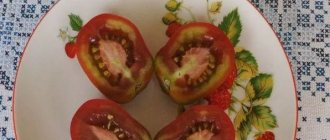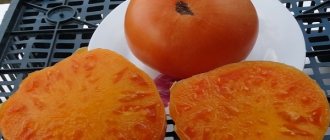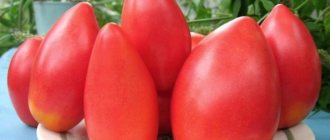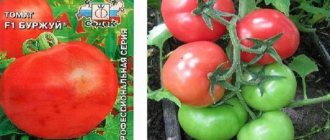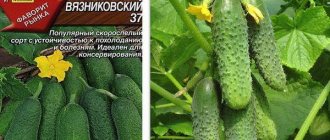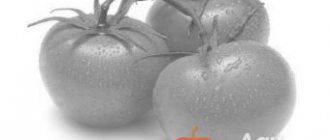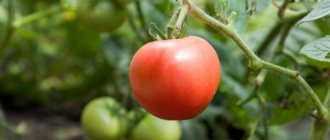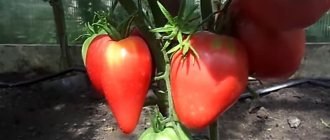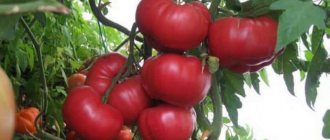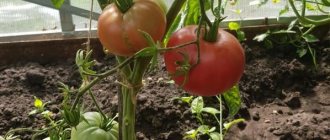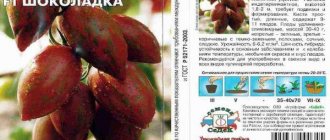The variety has an interesting history of origin. Kosovo was developed by an American after a trip to Yugoslavia (seeds were collected here, which became the basis for selection). The tomato is perfectly adapted to hot weather in midsummer. It shows stable setting regardless of upward temperature changes.
| Height | Landing location | Ripening time | Fruit color | Fruit size | Origin | Fruit shape |
| Tall | Greenhouse, Open ground | Mid-season | Reds | Large | Variety | Flat-round |
Description and characteristics of the variety
Farmers from different regions have already become familiar with the tomato. The variety is valued for its unpretentiousness, tolerance of temperature changes, and resistance to pathogens.
According to the ripening period, the tomato is classified as a mid-ripening group.
What features of the variety should you know:
- indeterminate growth;
- large fruit;
- mid-ripening;
- vigorous bushes (height 1.8-2 m).
The variety has 2 subspecies, which have outwardly similar bushes and types of brushes; the differences relate exclusively to the shape and color of the tomatoes. In the first type, the fruits resemble a heart and have rich raspberry flesh. The latter have a glossy red skin and a flattened shape.
8-10 fruits ripen on 1 plant with an average weight of about 0.5 kg.
General characteristics of tomatoes:
- average weight 300-500 g;
- maximum weight 800-900 g;
- crimson or red coloring;
- the skin is matte, durable, not cracking;
- consistency is moderately dense;
- tomatoes keep well for a month.
Productivity and reviews
On one bush of tomatoes ripen from 8 to 9 pieces. The weight of one fruit is from 400 to 500 grams, and the yield is up to 4 kilograms. A lot depends on proper care: watering, hilling, fertilizing the soil. Reviews about the Kosovo tomato are mostly positive, because it attracts with the size, shape and color of the fruit. Its beautiful appearance and outstanding taste make it attractive for purchase and cultivation in summer cottages and gardens. On the negative side, it should be noted that the bushes may look a little frail, but this depends on the characteristics of planting and caring for the variety.
Landing
The variety is cultivated through seedlings. Seeds are sown from the 2nd decade of February and throughout March. Pre-processing is reduced to the following procedures:
- disinfection with potassium permanganate;
- stimulation with aloe juice or drugs Epin, Agat, Zircon.
The sowing depth is 2 cm, the seeds are planted in moist soil. For tomatoes, purchase a special mixture for tomatoes and peppers or prepare turf soil. The following components are first added to it:
- like sand;
- peat;
- compost;
- vermiculite
Add 25-30 g of phosphorus-potassium additive to 10 kg of mixture.
What conditions are necessary for high-quality strong seedlings:
- humidification with warm water 24-25 degrees;
- compliance with the temperature regime (before germination 25-27 degrees, after germination 20-22 degrees);
- fertilizing 2 times (Kemira, nitroammofoska, mullein solution);
- picking and transplanting into separate cups if there are 2 leaves.
Features of the Kosovo variety
The Kosovo tomato is one of the mid-season tomatoes that ripens within 80 days and reaches a height of up to 2.5 meters. It is advisable to grow it in greenhouses, since there all the conditions can be created for the formation of bushes and large fruits in the future. The color of the tomatoes is pink. The fruits are very tasty and have a sweetish taste. There are few seeds, and the tomato itself is fleshy and juicy. The bush should be formed into no more than two stems. Also, good results are achieved by hilling up to the level of the first leaf to form additional roots.
Growing and care
Bushes are planted in beds at the age of 50-58 days
Per 1 m2 no more than 2 plants are placed under the film and 3 in open areas.
A handful of compost and Red Giant fertilizer are poured into the holes. Maintain a step of 50-60 cm between plants.
Nuances of agricultural technology:
- conducting in 2-3 barrels;
- preventive measures against pests;
- watering 3-4 times a week;
- fertilizer with organic matter and minerals, complexes (Fertika, Agricola, Effect).
Feeding is required once every 12-14 days, alternating root and foliar methods.
Preparing land and material for planting
Prepare the land for growing Kosovo tomatoes in the fall. To do this, you need to dig it up and add manure. Or mix the soil with humus. The same is done in the spring, in addition, 1 tbsp is added to the ground. l. potassium chloride and 5 tbsp. l. superphosphate.
Kosovo tomatoes are tall, so seedlings need to be sown 2.5-3 months before transferring them to an open area. This is usually done at the end of February, beginning of March. Buy Kosovo tomato seeds only in specialized stores.
See also
Description and characteristics of tomato Axiom f1, growing rules
Read
If you have already grown this variety before, then the seeds can be collected yourself.
How to grow tomatoes
To grow a rich and tasty harvest of Strega f1 tomatoes, follow our recommendations.
Landing
It is best to plant seedlings in open ground in cloudy weather or in the evening. The distance between the rows is 50–70 cm, and the sprouts are spaced 30–40 cm apart from each other.
Landing algorithm:
- Make holes 15 cm deep.
- Sprinkle each hole with plenty of water.
- Plant the seedlings, deepening them to the cotyledon leaves.
- Sprinkle the seedlings with soil, compact it so that the sprouts do not fall.
Important! Overgrown seedlings are tied to stakes.
Seedling care
Basic procedures for obtaining a rich harvest:
- Watering. There is no need to water the first week after planting the seedlings, because the sprouts need to take root. Then watering is carried out as the soil dries. The optimal water consumption for 1 bush is 2–5 liters. Tomatoes are watered only at the root, and not from above. It is recommended to loosen it every time the soil is moistened.
- Feeding. Fertilizers are applied for the first time 15–20 days after planting the seedlings. To do this, use ready-made complex formulations and prepare the solution in accordance with the instructions. The tomatoes are fed the second time after the first flowering and during the formation of buds. Fertilize the third time during the appearance of the first fruits.
- Pinching and pruning . Stepchildren take nutrients from plants, so they need to be removed. If this is not done, the growth of tomatoes and their fruiting will slow down, and may even stop altogether. Experts advise getting rid of unnecessary shoots exclusively with your fingers, without using pruners and scissors, while leaving stumps 1 cm long. Also, the Strega hybrid gets rid of the lower leaves - this procedure is performed after the first ovaries appear. Trimming the lower leaves is done with pruners or scissors.
- Garter. As soon as the bush grows above 50 cm, it is recommended to tie it up. It is best to use trellises.
Tomatoes after planting, first care, first feeding, first treatment for diseases
Features of cultivation and possible difficulties
In equipped greenhouses, Strega f1 tomato is grown even in winter. The culture is unpretentious to climatic conditions.
In open ground, it is not recommended to plant seedlings in a sunny place, otherwise the leaf blades will be burned. It is better to choose partial shade. Tomatoes should be protected from drafts. You cannot plant seedlings in a wetland. This will cause the stems and leaves to rot.
Diseases and pests
You should be concerned if spots appear on the leaf blades and fruits. The appearance of mold on the leaves is also dangerous. If such diseases occur, the affected parts must be removed and then the plant must be treated with fungicides.
The hybrid is resistant to the following diseases:
- fusarium;
- withering;
- late blight;
- tobacco mosaic virus.
The best remedies for tomato diseases are prevention (disinfection of seeds and soil, loosening, weeding) and proper agricultural technology.
Ulisse - variety of tomato plant
Information on the admission of Tomato Ulisse from the Register of the State Variety Commission of the Russian Federation
Application for admission No. 42088, registered 2004-12-01. The Tomato Ulisse variety was included in the register of those approved in 2007. Approved for use in the regions: North Caucasus.
The originator of the Tomato Ulisse variety is:
SYNGENTA SEEDS BV(WESTEINDE 62, PO BOX 2, 1600 AA ENKHUIZEN THE NETHERLANDS)
Other varieties of tomato plant
Question to the portal experts
If you haven't found the answer to a question, don't hesitate to ask an expert.
Register or Login so you don't have to enter your Name and Email every time
Thanks for the comment! It will be published after checking by a moderator!
No comments yet, be the first!
A portal for those who love their dacha
Your question has been sent for moderation. Don't worry, we quickly check your questions and your question will be answered within 1 day.
We have noticed that you are already registered on our website. We recommend that you log in to view the created question.
If you don't remember your password, you can recover it.
You were not registered until today, so we have registered you. Your password has been sent to your specified mailbox.
Help our site develop!
Please read this message, it will not take up much of your time!
We so need your comments and questions to understand in which direction we should develop.
Don't forget to leave a comment if you found what you were looking for. And if you haven’t found it, use the “Ask an Expert” form in the site header. We will answer this question, and other visitors will be able to find the information that you could not find.
Your question has been sent for moderation. Don't worry, we quickly check your questions and your question will be answered within 1 day.
We have noticed that you are already registered on our website. We recommend that you log in to view the created question.
If you don't remember your password, you can recover it.
You were not registered until today, so we have registered you. Your password has been sent to your specified mailbox.
Description of tomato Rally f1 and agricultural technology for cultivating the hybrid
The Rally tomato belongs to the group of early ripening hybrids. The variety is adapted for cultivation in open ground conditions in the southern regions of the country, the Volga region. For the middle zone, cultivation in greenhouses is recommended. Large fruits have excellent taste and tolerate transportation well.
Advantages of the variety
Rally f1 tomatoes are first generation hybrids. The super early variety begins to bear fruit 2 months after the seeds emerge. The culture is popular among vegetable growers due to the ability to obtain early produce.
During the growing season, tall branched bushes with abundant foliage of a dark emerald color are formed. Strong shoots can reach 0.6-0.75 m. The plant requires regular removal of stepsons and garters to supports or trellises.
The first peduncle is formed at the level of 4-5 permanent leaves. The ovaries are collected in racemose inflorescences of 5-6 flowers. The characteristics and description of the variety indicate the high productivity of the crop.
- Dense tomato fruits of rich red color.
- With a horizontal cut, up to 5-6 chambers with seeds are observed.
- Ripe tomatoes are round, slightly flattened.
- The weight of the fruit reaches 250-300 g.
The first tomatoes ripen in mid-June, but harvesting is delayed for a month. It is recommended to pick the fruits as they ripen. In cooking, tomatoes are used fresh. They are not suitable for canning due to their large size.
With the open growing method, 7.5-8 kg of fruits are collected from 1 m². In greenhouse conditions, the yield reaches 12 kg.
The description of the fruit indicates their density and resistance to cracking. Ripe tomatoes can withstand transportation over long distances.
For the Rally f1 tomato, the description indicates the immunity of the crop, resistance to late blight and fusarium. These tomatoes are not affected by tobacco mosaic virus, nematodes and brown spot.
Cultivation technique
When growing this variety, you must follow the first rule, which obliges you to select the best predecessors for the crop. When organizing crop rotation, preference is given to cucumbers, zucchini, cauliflower, carrots, and parsley.
One of the best ways to grow this hybrid tomato is to sow seeds into seedlings. To do this, at home, seeds are planted in prepared and moistened soil. You can use containers or individual pots for this purpose.
After the formation of 2 true leaves, the plants are picked. Planting material is transferred into open or closed ground into prepared holes. During the growing season, monitor the moisture level. The plants are hilled up and periodically fertilized with complex preparations according to the manufacturer’s scheme.
To increase the yield, it is recommended to mulch the soil with grass and special black fiber. This event allows you to maintain the balance of air and moisture near the root system.
Recommendations and opinions of vegetable growers
Reviews from gardeners growing the Rally hybrid indicate the high yield of the crop, excellent taste of large fruits, and the ability to be transported over long distances due to its dense skin.
Serafima Frolova, 59 years old, Cheboksary:
“I’ve been growing tomatoes in my summer cottage for many years. I am fond of tall varieties, since the conditions are specially created for this
The Rally variety attracted attention (except for the ability to form a tall bush) due to its large fruits. Juicy and soft fruits, with thick skin, very aromatic, pleasant to pick from the bush
They are not suitable for whole canning, but they can be used for salad or other dishes.”
Pavel Bogomolov, 62 years old, Astrakhan:
“On the recommendation of neighbors, I purchased the seeds of the Rally hybrid. The variety pleasantly surprised me with the ability to grow tomatoes in a greenhouse, high yield, and ease of care. A plant has formed, the appearance and characteristics of which are the same as in the packaging photo. The fruits are very large, juicy, and pleasant to the taste.”
